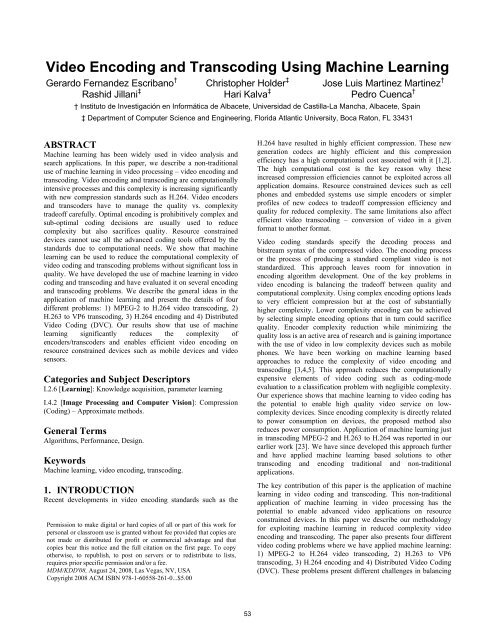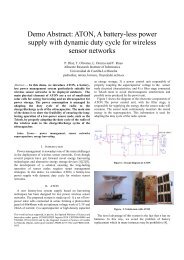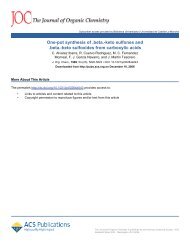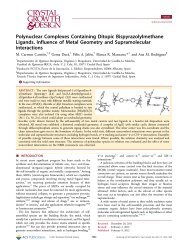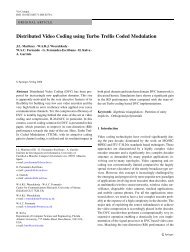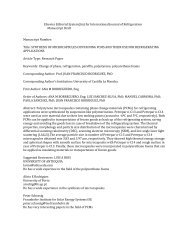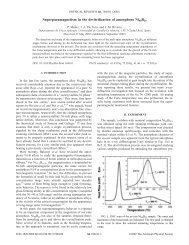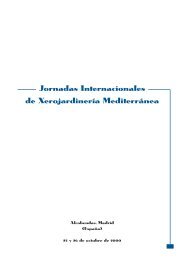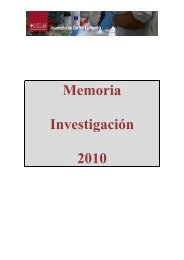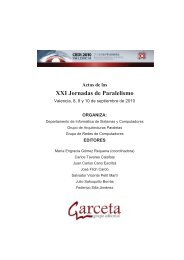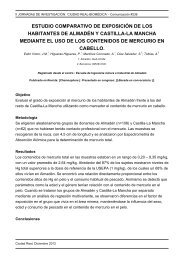Video Encoding and Transcoding Using Machine Learning
Video Encoding and Transcoding Using Machine Learning
Video Encoding and Transcoding Using Machine Learning
Create successful ePaper yourself
Turn your PDF publications into a flip-book with our unique Google optimized e-Paper software.
<strong>Video</strong> <strong>Encoding</strong> <strong>and</strong> <strong>Transcoding</strong> <strong>Using</strong> <strong>Machine</strong> <strong>Learning</strong><br />
Gerardo Fern<strong>and</strong>ez Escribano †<br />
Rashid Jillani ‡<br />
ABSTRACT<br />
<strong>Machine</strong> learning has been widely used in video analysis <strong>and</strong><br />
search applications. In this paper, we describe a non-traditional<br />
use of machine learning in video processing – video encoding <strong>and</strong><br />
transcoding. <strong>Video</strong> encoding <strong>and</strong> transcoding are computationally<br />
intensive processes <strong>and</strong> this complexity is increasing significantly<br />
with new compression st<strong>and</strong>ards such as H.264. <strong>Video</strong> encoders<br />
<strong>and</strong> transcoders have to manage the quality vs. complexity<br />
tradeoff carefully. Optimal encoding is prohibitively complex <strong>and</strong><br />
sub-optimal coding decisions are usually used to reduce<br />
complexity but also sacrifices quality. Resource constrained<br />
devices cannot use all the advanced coding tools offered by the<br />
st<strong>and</strong>ards due to computational needs. We show that machine<br />
learning can be used to reduce the computational complexity of<br />
video coding <strong>and</strong> transcoding problems without significant loss in<br />
quality. We have developed the use of machine learning in video<br />
coding <strong>and</strong> transcoding <strong>and</strong> have evaluated it on several encoding<br />
<strong>and</strong> transcoding problems. We describe the general ideas in the<br />
application of machine learning <strong>and</strong> present the details of four<br />
different problems: 1) MPEG-2 to H.264 video transcoding, 2)<br />
H.263 to VP6 transcoding, 3) H.264 encoding <strong>and</strong> 4) Distributed<br />
<strong>Video</strong> Coding (DVC). Our results show that use of machine<br />
learning significantly reduces the complexity of<br />
encoders/transcoders <strong>and</strong> enables efficient video encoding on<br />
resource constrained devices such as mobile devices <strong>and</strong> video<br />
sensors.<br />
Categories <strong>and</strong> Subject Descriptors<br />
I.2.6 [<strong>Learning</strong>]: Knowledge acquisition, parameter learning<br />
I.4.2 [Image Processing <strong>and</strong> Computer Vision]: Compression<br />
(Coding) – Approximate methods.<br />
General Terms<br />
Algorithms, Performance, Design.<br />
Keywords<br />
<strong>Machine</strong> learning, video encoding, transcoding.<br />
1. INTRODUCTION<br />
Recent developments in video encoding st<strong>and</strong>ards such as the<br />
Permission to make digital or hard copies of all or part of this work for<br />
personal or classroom use is granted without fee provided that copies are<br />
not made or distributed for profit or commercial advantage <strong>and</strong> that<br />
copies bear this notice <strong>and</strong> the full citation on the first page. To copy<br />
otherwise, to republish, to post on servers or to redistribute to lists,<br />
requires prior specific permission <strong>and</strong>/or a fee.<br />
MDM/KDD'08, August 24, 2008, Las Vegas, NV, USA<br />
Copyright 2008 ACM ISBN 978-1-60558-261-0...$5.00<br />
Christopher Holder ‡<br />
Hari Kalva ‡<br />
Jose Luis Martinez Martinez †<br />
Pedro Cuenca †<br />
† Instituto de Investigación en Informática de Albacete, Universidad de Castilla-La Mancha, Albacete, Spain<br />
‡ Department of Computer Science <strong>and</strong> Engineering, Florida Atlantic University, Boca Raton, FL 33431<br />
53<br />
H.264 have resulted in highly efficient compression. These new<br />
generation codecs are highly efficient <strong>and</strong> this compression<br />
efficiency has a high computational cost associated with it [1,2].<br />
The high computational cost is the key reason why these<br />
increased compression efficiencies cannot be exploited across all<br />
application domains. Resource constrained devices such as cell<br />
phones <strong>and</strong> embedded systems use simple encoders or simpler<br />
profiles of new codecs to tradeoff compression efficiency <strong>and</strong><br />
quality for reduced complexity. The same limitations also affect<br />
efficient video transcoding – conversion of video in a given<br />
format to another format.<br />
<strong>Video</strong> coding st<strong>and</strong>ards specify the decoding process <strong>and</strong><br />
bitstream syntax of the compressed video. The encoding process<br />
or the process of producing a st<strong>and</strong>ard compliant video is not<br />
st<strong>and</strong>ardized. This approach leaves room for innovation in<br />
encoding algorithm development. One of the key problems in<br />
video encoding is balancing the tradeoff between quality <strong>and</strong><br />
computational complexity. <strong>Using</strong> complex encoding options leads<br />
to very efficient compression but at the cost of substantially<br />
higher complexity. Lower complexity encoding can be achieved<br />
by selecting simple encoding options that in turn could sacrifice<br />
quality. Encoder complexity reduction while minimizing the<br />
quality loss is an active area of research <strong>and</strong> is gaining importance<br />
with the use of video in low complexity devices such as mobile<br />
phones. We have been working on machine learning based<br />
approaches to reduce the complexity of video encoding <strong>and</strong><br />
transcoding [3,4,5]. This approach reduces the computationally<br />
expensive elements of video coding such as coding-mode<br />
evaluation to a classification problem with negligible complexity.<br />
Our experience shows that machine learning to video coding has<br />
the potential to enable high quality video service on lowcomplexity<br />
devices. Since encoding complexity is directly related<br />
to power consumption on devices, the proposed method also<br />
reduces power consumption. Application of machine learning just<br />
in transcoding MPEG-2 <strong>and</strong> H.263 to H.264 was reported in our<br />
earlier work [23]. We have since developed this approach further<br />
<strong>and</strong> have applied machine learning based solutions to other<br />
transcoding <strong>and</strong> encoding traditional <strong>and</strong> non-traditional<br />
applications.<br />
The key contribution of this paper is the application of machine<br />
learning in video coding <strong>and</strong> transcoding. This non-traditional<br />
application of machine learning in video processing has the<br />
potential to enable advanced video applications on resource<br />
constrained devices. In this paper we describe our methodology<br />
for exploiting machine learning in reduced complexity video<br />
encoding <strong>and</strong> transcoding. The paper also presents four different<br />
video coding problems where we have applied machine learning:<br />
1) MPEG-2 to H.264 video transcoding, 2) H.263 to VP6<br />
transcoding, 3) H.264 encoding <strong>and</strong> 4) Distributed <strong>Video</strong> Coding<br />
(DVC). These problems present different challenges in balancing
the quality complexity tradeoff. The results show that machine<br />
learning techniques can reduce the complexity significantly with<br />
negligible loss in quality.<br />
2. MACHINE LEARNING AND VIDEO<br />
CODING<br />
<strong>Machine</strong> learning has been widely used in image <strong>and</strong> video<br />
processing for applications such as content based image <strong>and</strong> video<br />
retrieval (CBIR), content underst<strong>and</strong>ing, <strong>and</strong> video mining. The<br />
key to successfully employing machine learning for low<br />
complexity video coding is selection of attribute <strong>and</strong> the classifier<br />
to be able to reduce encoder coding mode selection to a<br />
classification problem. The attributes have to be computationally<br />
inexpensive <strong>and</strong> still be effective when used for classification.<br />
Since mode decisions are significantly influenced by the amount<br />
of detail <strong>and</strong> similarity among the macro blocks, features that<br />
describe the content can be used. MPEG-7 committee has<br />
st<strong>and</strong>ardized descriptors for describing content based features<br />
such as texture, color, shape, <strong>and</strong> motion [6]. Features such as<br />
homogenous texture could predict MB type <strong>and</strong> the edge<br />
histogram is potentially useful for deriving Intra MB prediction<br />
directions. While these features are potentially useful, the<br />
computational cost of extracting these features would offset any<br />
resulting complexity reduction. A feature set that uses negligible<br />
computation for feature extraction is necessary to develop low<br />
complexity video coding solutions.<br />
Our proposed approach is summarized in Figures 1. The basic<br />
idea is to determine encoder decisions such as MB coding mode<br />
decisions that are computationally expensive using easily<br />
computable features derived from input video. The input video is<br />
compressed in the case of transcoding problems <strong>and</strong><br />
uncompressed in case of encoding problems. A machine learning<br />
algorithm/classifier is used to deduce the decision tree based on<br />
such features. Once a tree is trained, the encoder coding mode<br />
decisions that are normally done using cost-based models that<br />
evaluate all possible coding options are replaced with a decision<br />
tree. Decision trees are in effect if-else statements in software <strong>and</strong><br />
require negligible computing resources. We believe this simple<br />
approach has the potential to significantly reduce encoding<br />
complexity <strong>and</strong> enable new class of video services. The key<br />
challenges in the proposed approach are: 1) Selecting the training<br />
set, 2) Determining the features/attributes, <strong>and</strong> 3) Selecting the<br />
classifier.<br />
(a) (b)<br />
Figure 1. (a) Applying machine learning to build decision<br />
trees (b) Low complexity video encoder using decision trees<br />
2.1 Selecting the Training Set<br />
Selecting a training set to encode all natural video is a challenging<br />
problem. The training set has to have all possible content for<br />
proper classification. On the other h<strong>and</strong> using a large training set<br />
could result in a large <strong>and</strong> complex decision tree. Upon closer<br />
54<br />
observation, the problem seems more manageable. Most of the<br />
video encoding mode decisions are based on the similarity<br />
(distance) of the block being encoded to those that are already<br />
coded. For Intra prediction in H.264, the similarity of the pixels in<br />
the current block to the edge pixels of the neighboring block<br />
determines the mode. For Inter MB coding, the similarity of the<br />
current block to the blocks in the previously coded frames<br />
determines the mode. A good training set should thus include not<br />
all possible colors <strong>and</strong> textures but enough blocks with similarity<br />
measures or distance metrics that are commonly found in typical<br />
video coding applications. Since video is usually encoded on a<br />
block-by-block basis, the training set should have enough blocks<br />
to ensure a good classification. The blocks selected for training<br />
can come from a single video or multiple video sequences.<br />
Considering that a frame of video at 720x480 resolution has 1350<br />
macro blocks, even a single frame of video can provide a<br />
sufficiently large training set. Such a training set is developed<br />
empirically.<br />
2.2 Determining the <strong>Video</strong> Features<br />
Image <strong>and</strong> video features have been used in content based<br />
retrieval of images <strong>and</strong> videos [7, 8]. The features that are<br />
typically used in content based retrieval describe the images <strong>and</strong><br />
video segments. These features describe color, shape, texture, <strong>and</strong><br />
motion <strong>and</strong> are developed for content retrieval <strong>and</strong> underst<strong>and</strong>ing<br />
applications. The features that are of interest in determining the<br />
coding modes are the similarity between current block <strong>and</strong> the<br />
previously coded blocks <strong>and</strong> the self-similarity of the current<br />
block. Simple metrics such as mean <strong>and</strong> variance could be<br />
sufficient to characterize a block coding mode. We have shown in<br />
our video transcoding work that variance of the DC coefficients<br />
of 8x8 blocks of an MPEG-2 Intra MB can be used to determine<br />
the Intra coding mode in H.264 [9]. Since the DC coefficient<br />
essentially gives the mean of a block, variance of means of 8x8<br />
sub-blocks could be used to characterize the Intra coding mode.<br />
However, as the number of coding modes increase, new features<br />
have to be developed to refine the classification of the coding<br />
modes. We have developed feature sets for each of the problems<br />
based on experimentation <strong>and</strong> performance analysis. We saw that<br />
the encoding complexity affects the resulting video quality. The<br />
use of more complex features improves the rate-distortion (RD)<br />
performance of an encoder but increase the computational<br />
complexity. The problems presented in Sections 3 to 6 discuss<br />
feature selection for the specific problems.<br />
2.3 Selecting the Classifier<br />
Classifier selection is another challenging task. The classifier has<br />
to be able to discover correlations between the attributes <strong>and</strong><br />
classes. Classification algorithms have been used in content<br />
analysis in images <strong>and</strong> video [10,11]. These algorithms can be<br />
supervised or unsupervised. Since complexity reduction is the<br />
primary goal here, supervised learning is more appropriate. We<br />
use the general purpose classifier, C4.5 [12]. The C4.5 algorithm<br />
is shown to be a broad general purpose classifier that performs<br />
well for a large class of problems [13]. Our results showed that<br />
C4.5 performs very well for video coding problems.<br />
The decision tree for the transcoder was made using the WEKA<br />
data mining tool [14]. The files that are used for the WEKA data<br />
mining program are known as Attribute-Relation File Format<br />
(ARFF) files. An ARFF file is written in ASCII text <strong>and</strong> shows<br />
the relationship between a set of attributes. This file has two
different sections: 1) the header which contains the name of the<br />
relation, the attributes that are used, <strong>and</strong> their types; <strong>and</strong> 2) the<br />
section containing the data. The WEKA tool takes the ARFF file<br />
as input <strong>and</strong> outputs a decision tree <strong>and</strong> the corresponding<br />
confusion matrix. The decision trees are converted to a C++ code<br />
using a tree-to-C++ conversion tool we have developed <strong>and</strong> used<br />
in the encoder/transcoder implementation.<br />
2.4 Performance Evaluation<br />
The performance of video coding <strong>and</strong> transcoding is evaluated<br />
using an RD curve that shows a measure of distortion at a given<br />
bitrate. The RD curve alone shows coding efficiency <strong>and</strong> does not<br />
reflect complexity. Time complexity is measured as percentage<br />
reduction in video encoding or transcoding time compared to a<br />
reference method [18]. The goal is to achieve RD performance<br />
close to the reference methods at a significantly lower<br />
complexity.<br />
The performance of the decision tree (recall <strong>and</strong> precision) is<br />
important but not critical. In video coding applications, the cost of<br />
misclassification is reflected in reduced RD performance <strong>and</strong> the<br />
amount of performance loss is dependent on content <strong>and</strong> the type<br />
of misclassification. To reduce the impact of such<br />
misclassification, hierarchical decision trees are used such that a<br />
wrongly classified mode falls in a related mode. The learning<br />
stage is offline <strong>and</strong> supervised <strong>and</strong> the decision tree deduced is<br />
implemented in the encoder or transcoder. There is no way of<br />
determining the optimal mode at runtime <strong>and</strong> any feedback based<br />
refinement is not possible. The additional complexity due to this<br />
approach is implementation of feature computation <strong>and</strong> decision<br />
trees. With careful feature selection, this represents a negligible<br />
increase in complexity compared to the complexity reduced.<br />
Complexity is reduced because of the elimination of the cost<br />
based encoding mode selection. Since the mode selection no<br />
longer computes costs of all possible options, the modes used in<br />
machine learning based solutions are sub-optimal <strong>and</strong> lead to<br />
slightly reduced RD performance.<br />
3. MPEG-2 TO H.264 TRANSCODING<br />
The MPEG-2 video coding st<strong>and</strong>ard is widely used in digital<br />
video applications including digital TV, DVD, <strong>and</strong> HDTV<br />
applications. While MPEG-2 is widely deployed, a new video<br />
coding st<strong>and</strong>ard known as H.264 or MPEG-4 AVC is gaining<br />
significant interest due to its improved performance [1]. The<br />
H.264 video provides equivalent video quality at 1/3 to 1/2 of<br />
MPEG-2 bitrates. However, these gains come with a significant<br />
increase in encoding <strong>and</strong> decoding complexity [15]. Given the<br />
wide deployment of MPEG-2 infrastructure, MPEG-2 <strong>and</strong> H.264<br />
are likely to coexist even as H.264 systems are deployed. The<br />
coexistence of these technologies necessitates systems that can<br />
leverage MPEG-2 <strong>and</strong> H.264 to provide innovative digital video<br />
services making use of MPEG-2 for current devices <strong>and</strong> H.264 for<br />
new generation receivers. The key to making this seamless is by<br />
transcoding MPEG-2 to H.264 at the appropriate points in the<br />
video distribution infrastructure: at the sender, in the network, or<br />
even at the receiver. However, given the significant differences<br />
between both encoding algorithms, the transcoding process of<br />
such systems is a much more complex task than other<br />
heterogeneous video transcoding processes [16,17].<br />
55<br />
3.1 Selecting the Training Set<br />
The training sets were made using MPEG-2 sequences encoded at<br />
higher than the typical broadcast encoding rates for the same<br />
quality, since the B frames are not used. The H.264 decisions in<br />
the training set were obtained from encoding the MPEG-2<br />
decoded sequence with a quantization parameter of 25 <strong>and</strong> RD<br />
optimized mode decision option enabled. After extensive<br />
experimentation, we found that sequences that contain regions<br />
varying from homogenous to high-detail serve as good training<br />
sets. Good sample sequences could be Flower Garden <strong>and</strong><br />
Football (sequences commonly used in video coding research).<br />
The goal is to develop a single, generalized, decision tree that can<br />
be used for transcoding any MPEG-2 video. We found that<br />
training based just on the Flower Garden sequence was sufficient<br />
to make accurate decisions for all videos, due to the complexity<br />
<strong>and</strong> variety of motion <strong>and</strong> texture in the sequence.<br />
The incoming video sequence, which is used to train the model, is<br />
decoded <strong>and</strong> during the decoding stage, the MB coding mode, the<br />
Coded Block Pattern (CBPC), <strong>and</strong> the mean <strong>and</strong> variance of the<br />
residual information for this MB (calculated for its 4x4 subblocks<br />
– resulting in 16 means <strong>and</strong> 16 variances for each MB) are<br />
saved. The decoded sequence is then encoded using the st<strong>and</strong>ard<br />
H.264 encoder. The coding mode of the corresponding MBs in<br />
H.264 is also saved. For each macroblock, each of one of the<br />
instances in the training set uses the following predictive<br />
attributes: i) Thirty two numerical variables: sixteen means <strong>and</strong><br />
sixteen variances of the 4x4 motion estimation residual subblocks,<br />
ii) the MB mode in MPEG-2, iii) the CBPC in MPEG-2,<br />
iv) <strong>and</strong> the corresponding H.264 MB coding mode decision for<br />
that MB as determined by the st<strong>and</strong>ard reference software.<br />
Finally, the class variable, i.e, the one that we are trying to<br />
underst<strong>and</strong>, classify, or generalize is the H.264 MB coding mode,<br />
<strong>and</strong> can take four values: skip, 16x16, 8x8 or Intra, in the first<br />
level of the decision tree proposed.<br />
3.2 Decision Trees<br />
The decision tree, that we are going to proposed to solve the interprediction<br />
problem, is a model of the data that encodes the<br />
distribution of the class label (MB mode in H.264) in terms of the<br />
attributes (MB mode in the incoming sequence, CBPC, Mean <strong>and</strong><br />
Variance), as we resumed in the previous sub-section. Figure 2<br />
shows the decision trees built<br />
using the process depicted in<br />
Figure 1.<br />
As shown in Figure 2, the<br />
Decision Tree for the proposed<br />
transcoder is a hierarchical<br />
decision tree with three different<br />
WEKA trees: 1) classifier for<br />
Figure 2. The Decision Tree<br />
Intra, Skip, Inter 16x16, <strong>and</strong><br />
Inter 8x8, 2) classifier to classify inter 16x16 into one of 16x16,<br />
16x8, <strong>and</strong> 8x16 MBs <strong>and</strong> 3) classifier to classify inter 8x8 into<br />
one of 8x8, 8x4, 4x8, or 4x4.<br />
Flower garden sequence produces datasets with 1204, 906, <strong>and</strong><br />
256 instances; <strong>and</strong> 38, 38 <strong>and</strong> 14 attributes used to train the<br />
decision trees placed in node1, node3 <strong>and</strong> node4 respectively.<br />
Table 1 summarizes the decision trees obtained from the learning<br />
process; #leaves, #nodes <strong>and</strong> #vars st<strong>and</strong> for the number of leaves,
inner nodes <strong>and</strong> variables included in the tree. These statistics can<br />
give us a measure about the complexity of the learnt trees,<br />
because the number of leaves coincides with the number of<br />
generated rules <strong>and</strong> the number of nodes gives us an idea about<br />
the number of conditions to be tested per rule.<br />
Table 1. Main data for the trees<br />
MPEG-2 to H.264<br />
#leaves #nodes #vars e(10CV)<br />
Tree at Node1 27 23 17 15.11<br />
Tree at Node3 63 59 32 28.80<br />
Tree at Node4 13 9 7 28.20<br />
As we can see the number of rules is not excessive, 103 for the<br />
MPEG-2 hierarchical classifier, <strong>and</strong> from the number of inner<br />
nodes we observe that the obtained rules have few conditions to<br />
be tested in their antecedent. With respect to the number of<br />
variables used in the tree, it is clear that it is in the first level when<br />
more variables can be considered as redundant because only 17<br />
are used from the 38 available. With respect to the last column, it<br />
shows the expected error for our classifier computed by using a<br />
st<strong>and</strong>ard technique as it is 10 fold cross-validation (10cv).<br />
Table 2 shows the error obtained when using a classifier learnt<br />
using the training set obtained from the Flower Garden sequence,<br />
<strong>and</strong> using as test set the arff files obtained from three different<br />
sequences: Akiyo, Paris <strong>and</strong> Tempete (n/a means that the result is<br />
not available because no records where labeled as 8x8 in the<br />
Akiyo sequence). The goal of this experiment is to show the<br />
generalization power of the learnt classifiers, i.e., its capability<br />
when used to test unseen sequences. As we can see the average<br />
error in each level is even lower than the cross validated error<br />
computed over the Flower Garden sequence (the sequence used<br />
for training), so we can conclude that our classifiers exhibit a<br />
good generalization behavior.<br />
Table 2. Results of evaluating the learnt classifier<br />
MPEG-2 to H.264<br />
Akiyo Paris Tempete<br />
Tree at Node1 13.40 12.28 14.06<br />
Tree at Node3 0.00 23.30 42.14<br />
Tree at Node4 n/a 18.75 8.33<br />
3.3 Performance Evaluation<br />
In order to evaluate the proposed macroblock partition mode<br />
decision algorithm for heterogeneous MPEG-2 to H.264 video<br />
transcoder proposed in this section, we have implemented the<br />
proposed approach based on the JM10.2 version of the H.264<br />
reference software. The additional computation here is the<br />
computation of the mean <strong>and</strong> variance of the 4x4 sub-blocks of<br />
the residual MBs. The MB coding mode decision determined by<br />
the decision trees is used in the low complexity H.264 encoding<br />
stage. This is an H.264 reference encoder with the MB mode<br />
decision replaced by simple mode assignment from the decision<br />
tree. The H.264 video encoder takes as input the decoder MPEG-<br />
2 (pixel data), the residual information, the mode decision <strong>and</strong> the<br />
CBPC for each macroblock of the P frames.<br />
Experiments were conducted to evaluate the performance of the<br />
proposed algorithm when transcoding videos at CIF resolution.<br />
The input bit-rate for the MPEG-2 sequences is 1.15 Mbits/sec<br />
(progressive format), the GOP size is 12 -I11(P)-, <strong>and</strong> the<br />
maximum motion search range is 15.<br />
56<br />
For re-encoding the input sequences, we use quantization<br />
parameters (QP) from QP = 28 to QP = 40. The size of the GOP is<br />
12 frames; with the same GOP format than in the input sequences.<br />
The rate control <strong>and</strong> CABAC algorithms were disabled for all the<br />
simulations. RD-optimized option is enabled. The number of<br />
reference in P frames was set to 1 <strong>and</strong> the motion search range<br />
was set to ± 16 pels with a MV resolution of ¼ pel. The<br />
ProfileIDC was set to High for all the simulations, with the FRExt<br />
options enabled. The other parameters were set to the default<br />
option. The time results were normalized, so they are independent<br />
from the machine used to run the simulations. The results are<br />
reported for five different sequences. The performance of the<br />
proposed very low complexity transcoder is compared with a<br />
reference transcoder comprised of a full MPEG-2 decoder<br />
followed by a full H.264 encoder. The metrics used to evaluate<br />
the comparative performance are: the rate-distortion function, the<br />
difference of coding time (∆Time), the PSNR difference (∆PSNR)<br />
<strong>and</strong> the bit-rate difference (∆Bitrate). The detail procedures in<br />
calculating these differences can be found from a JVT document<br />
authored by Bjontegaard [18].<br />
Akiyo<br />
Paris<br />
Stefan<br />
Tempete<br />
Figure 3. Rate Distortion Results<br />
Figure 3 shows the Rate Distortion results of applying the<br />
following options: Full RD-optimized H.264 encoding with the<br />
reference transcoder <strong>and</strong> the proposed low complexity H.264<br />
encoding stage, in the MPEG-2/H.264 transcoder scenario. The<br />
PSNR obtained when applying our algorithm deviates slightly<br />
from the results obtained when applying the considerably more<br />
complex full RD-optimized H.264 encoding with the MPEG-<br />
2/H.264 reference transcoder.<br />
Mobile<br />
Table 3. ΔBitRate, ΔPSNR <strong>and</strong> Time Reduction results.<br />
Proposed (MPEG-2/H.264)<br />
Sequence Time (%) ΔPSNR (dB) ΔBitRate (%)<br />
Akiyo - 72.49 - 0.052 1.78<br />
Paris - 73.63 - 0.083 3.75<br />
Tempete - 71.01 - 0.045 2.95<br />
Stefan - 71.10 - 0.245 13.76<br />
Mobile - 70.04 - 0.012 0.96<br />
Table 3 shows the results in terms of ∆Time, ∆PSNR <strong>and</strong> ∆Bitrate<br />
for the proposed data mining based encoding stage compared with<br />
the RD optimized encoding stage for encoding 200 frames of each<br />
sequence. PSNR <strong>and</strong> bit-rate differences are calculated according
to the numerical averages between<br />
the RD-curves derived from JM<br />
encoder, the algorithm under study.<br />
The negligible drop in RD<br />
performance is more than offset by<br />
the reduction in computational<br />
complexity. However, in terms of<br />
time saving, which is a critical issue<br />
in video transcoding applications,<br />
Table 5: MB mode distribution in VP-6<br />
Inter 0,0 Intra<br />
the proposed method significantly reduces the time for reencoding<br />
the sequences.<br />
4. FLASH VIDEO TRANSCODING<br />
Adobe’s Flash video has become the dominant format for video<br />
distribution on the Internet. Flash 6 video format is essentially<br />
H.263 <strong>and</strong> a lot of content exists in this format. Flash 8 used VP6<br />
compression for video. Flash 8 is widely used today even as Flash<br />
9 with additional H.264 support became available. Flash video<br />
transcoding transcodes H.263 to VP-6 formats to enable low<br />
complexity Flash 6 to Flash 8 transcoding.<br />
H.263 is a video coding st<strong>and</strong>ard developed under the auspice of<br />
the ITU. The st<strong>and</strong>ard was developed targeting low bitrate video<br />
applications in telecommunications. H.263 is a hybrid video<br />
coding format similar to the MPEG video codecs. The baseline<br />
profile of H.263 with Annex-D, unrestricted motion vector mode,<br />
<strong>and</strong> Annex-F, Advanced prediction mode, is used as the input to<br />
the transcoder.<br />
Table 4: Comparison of VP6 <strong>and</strong> H.263 Coding Features<br />
Feature H.263 Baseline VP6<br />
Picture type I, P I, P<br />
Transform size 8x8 8x8<br />
Transform DCT Integer DCT<br />
Intra prediction None None<br />
Motion comp. 16x16, 8x8 16x16, 8x8<br />
Total MB modes 4 10<br />
Motion vectors ½ pixel ¼ pixel<br />
Deblocking filter None Yes<br />
Reference frames 1 Max 2<br />
VP6 is a proprietary video compression algorithm developed by<br />
On2 Technologies. VP6 is also a hybrid codec that uses motion<br />
compensated transform coding at its core. Motion compensation<br />
supports 16x16 <strong>and</strong> 8x8 blocks similar to H.263 but the Inter 8x8<br />
macro blocks can have mixed blocks; i.e., one or more 8x8 blocks<br />
can be coded in Intra mode without using any prediction. The<br />
Inter MBs in VP6 can be coded using 9 different modes. The<br />
modes are characterized by the number of motion vectors (1 vs.<br />
4), reference frame used, <strong>and</strong> whether motion vectors are coded.<br />
Table 4 summarizes the similarities <strong>and</strong> differences between<br />
H.263 baseline profile <strong>and</strong> the VP6 encoder. The large number of<br />
coding modes supported in VP6, the ¼ pixel resolution motion<br />
vectors, <strong>and</strong> multiple reference frames allowed make transcoding<br />
from H.263 to VP6 difficult. The transcoding algorithms are<br />
designed for Inter frames <strong>and</strong> focus on reusing the motion<br />
information.<br />
4.1 Selecting the Training Set<br />
Training set selection was important for this transcoder. Both of<br />
the video st<strong>and</strong>ards used in the Flash transcoder have much lower<br />
complexity compared to H.264. This gives the challenge of<br />
Inter+<br />
MV<br />
Nearest Near Golden Golden<br />
MV<br />
Inter<br />
4V<br />
Golden<br />
Nearest<br />
providing low complexity calculations for the attributes used for<br />
these trees. The variables which are used are based off the residue<br />
from the macroblock for the decoded frame. Since the smallest<br />
block size available in VP6 is 8x8, the means of the 4x4 blocks<br />
were not used. Also only the residue of the luma was used for the<br />
means. The means of 8x8 <strong>and</strong> 16x16, variance of the 16x16, the<br />
coded block pattern <strong>and</strong> also the inter 0,0 error (difference with<br />
collocated block in reference frame) was used. The coded block<br />
pattern is the binary representation of the coded blocks in a macro<br />
block. Because of VP6 implementation, the inter 0,0 decision has<br />
to be generated for all decisions so using it into the tree does not<br />
add complexity. The variables chosen have low complexity <strong>and</strong><br />
are calculated using integer arithmetic to avoid floating point<br />
complexity.<br />
The training process was performed by using eight different<br />
sequences. The first P frame of each was use for the data to<br />
produce the trees. Also all combinations of the attributes were<br />
evaluated in order to determine the attributes that result in best<br />
classification. These trees were then tested against a test file<br />
which contained 100 frames of each of the training sequences.<br />
The best tree was chosen for its accuracy <strong>and</strong> confusion matrix<br />
which had the best precision.<br />
4.2 Decision Trees<br />
Table 5 shows how each of the H.263 MBs are coded in VP6 for a<br />
typical sequence. Based on Table 5, one can observe that the<br />
distribution of the modes greatly depends on the H.263 mode.<br />
With C4.5, the modes which are in the minority have a good<br />
chance of being misclassified <strong>and</strong> overlooked. However, having<br />
separate trees which depend on the H.263 mode allows proper<br />
classification of minority modes. This results in much more<br />
efficient decision trees. This multi-tree approach also reduces<br />
misclassification on the Inter 4V <strong>and</strong> Intra modes.<br />
Figure 4. Decision trees used in VP-6 transcoding (a)<br />
Flawed top (b) H.263 Mode Separated trees<br />
Golden<br />
Near<br />
Inter 17% 0% 21% 38% 21% 0% 1% 2% 0% 0%<br />
Inter 4V 3% 1% 30% 11% 7% 1% 1% 47% 0% 0%<br />
Intra 11% 33% 4% 9% 4% 11% 3% 19% 4% 2%<br />
Skipped 60% 0% 0% 31% 8% 0% 0% 0% 0% 0%<br />
57<br />
Our experiments showed that hierarchical trees preformed better<br />
than a tree which had only one level <strong>and</strong> many decisions. Figure 4<br />
shows two of the multi-level trees used. The goal is to classify the<br />
MB coding mode into one of Skip, Inter 1MV, or Inter 4 MV.<br />
Classifying H.263 MB into three classes is error prone <strong>and</strong> a<br />
hierarchical classifier was designed. Different configurations of<br />
trees were evaluated, but not all will be discussed because of<br />
space considerations. The two trees with the best results were : 1)<br />
H.263 Mode Separated trees 2) Flawed Top tree. These are shown<br />
in Figure 4.
The H.263 Mode Separated tree (Fig. 4.b) had four trees for each<br />
of the H.263 modes <strong>and</strong> each of these trees selects one of three<br />
VP-6 modes. This has low complexity <strong>and</strong> the ability to predict<br />
accurately. The Flawed Top tree is a hierarchical tree with the top<br />
level tree making skipped vs. non-skipped decision. Because of<br />
implementation dependencies, Intra cost is evaluated before any<br />
of the tree decisions are invoked. Some MBs may be coded as<br />
Intra if the Intra cost evaluated is lower than the cost of mode<br />
selected by the trees. Four second level trees (2 – 5 in Fig. 4.a),<br />
for each of the four H.263 modes, are trained with data which<br />
would have come from first tree. This tree classifies the MB into<br />
one of the two modes.<br />
4.3 Performance Evaluation<br />
All the results reported in this paper use the TMN 3.2 H.263<br />
encoder from University of British Columbia which is based on<br />
Telenor's H.263 implementation. The input video is coded at 512<br />
Kbps in baseline profile with advanced motion options <strong>and</strong> one I<br />
frame (first frame). A decoder based on the same H.263<br />
implementation is used in the decoding stage of the transcoder.<br />
The VP-6 encoding stage is based on the optimized VP-6 encoder<br />
software provided by ON2 Technologies. The VP-6 video is<br />
encoded with I frame frequency of 120 <strong>and</strong> at multiple bitrates to<br />
assess the RD performance of the transcoder. The results are<br />
compared with the baseline transcoder that performs full encoding<br />
in the VP-6 encoding stage.<br />
Table 6. The RD performance of the Trees<br />
Decision tree/Sequence used<br />
PSNR (dB)<br />
35<br />
34<br />
33<br />
32<br />
31<br />
30<br />
29<br />
28<br />
Time<br />
(%)<br />
Rate vs. Distortion (352x288, CIF)<br />
ΔPSNR<br />
(dB)<br />
CoastGuard Baseline<br />
CoastGuard H.263 Seperated<br />
CoastGuard Flawed Top<br />
Football Baseline<br />
Football H.263 Seperated<br />
Football Flawed Top<br />
27<br />
0 200000 400000 600000<br />
Bitrate<br />
800000 1e+006<br />
Figure 5. Transcoder performance<br />
ΔBitrate<br />
(%)<br />
H.263 separate trees/Coastguard -48.4 0.10 2.09<br />
H.263 separate trees/Football -50.7 0.12 6.15<br />
Flawed top/Coastguard -39.0 0.10 2.74<br />
Flawed top/Football -44.1 -0.12 -1.75<br />
The RD performance of the transcoder using the full set of trees<br />
evaluated is shown in Table 6. The results show that the RD<br />
performance is very close to the baseline transcoder. Figure 5<br />
shows the average transcoder performance summary for two of<br />
the tested sequences transcoded from 128 Kbps to 512 Kbps. The<br />
H.263 mode separated tree gives the best performance as this<br />
minimizes the additional computation for mode decision. This<br />
tree uses a single decision tree for each MB based on the H.263<br />
mode while the Flawed Top tree uses two decision trees. The<br />
58<br />
results show that the speedup can be as high as 2.1. The average<br />
speedup is 1.7; i.e., transcoding algorithms increase the transcoder<br />
capacity by 70%. Considering that the VP-6 encoder is an<br />
optimized implementation, 70% improvement is a highly<br />
significant improvement.<br />
5. H.264 ENCODING<br />
In this section we present the application of machine learning in<br />
Intra frame encoding in H.264. H.264/AVC is the state of the art<br />
video compression st<strong>and</strong>ard <strong>and</strong> has been designed for a wide<br />
range of applications. The compression efficiency of H.264 has<br />
increased mainly because of the large number of coding options<br />
available. For example, the H.264 video supports Intra prediction<br />
with 3 different block sizes (plus up to 9 prediction directions per<br />
block size) <strong>and</strong> Inter prediction with 8 different block sizes. The<br />
encoding of a macro block (MB) is a complex operation as it<br />
involves evaluating all the possible coding options <strong>and</strong> selecting<br />
an option that has the least cost associated with it. Most H.264<br />
encoder implementations on mobile devices today do not<br />
implement the st<strong>and</strong>ard profiles fully due to high complexity.<br />
The key idea behind this approach is to exploit the correlation<br />
between the structural information in a video frame <strong>and</strong> the<br />
corresponding H.264 MB mode decisions. In this approach,<br />
encoder decisions such as MB coding mode decisions that are<br />
computationally expensive are replaced with mode decisions from<br />
a low complexity decision tree (see Fig. 1).<br />
5.1 Selecting the Training Set<br />
The training set of videos was selected based on the extensive<br />
empirical experiments. The results from one sequence were<br />
verified by cross validating with the other sequences. Based on<br />
our observations from our earlier work (MPEG-2 to H.264<br />
encoding <strong>and</strong> DVC encoding), Flower Garden <strong>and</strong> Mobile are the<br />
best training sequences as discussed in the relevant sections of<br />
this paper. To generate a single generic decision tree which<br />
produces optimal results for all sequences is very difficult;<br />
therefore, a best compromise is chosen to apply to all sequences<br />
to minimize the drop in RD performance.<br />
Training set of a sequence that is used as an input to WEKA<br />
contains the attribute values <strong>and</strong> the MB mode selected for each<br />
MB. The number of instances used to get good decision trees vary<br />
for 16x16 <strong>and</strong> 4x4 modes. Since the number of 4x4 modes can be<br />
greater than that of 16x16 modes in a given frame, therefore we<br />
need more frames to create training set for 16x16 modes <strong>and</strong> less<br />
frames to create training set for 4x4 modes. For each macroblock,<br />
the training set for top level node decision (Intra 16x16 vs. Intra<br />
4x4) involves only two attributes i.e. mean of MB <strong>and</strong> variance of<br />
16 4x4 means in an MB <strong>and</strong> also the corresponding H.264/AVC<br />
MB coding mode decision for that MB as determined by the<br />
st<strong>and</strong>ard reference software. The number of attributes is carefully<br />
determined based on the observations about the properties of the<br />
attributes chosen <strong>and</strong> the resulting performance. For example,<br />
deciding between Intra 16x16 <strong>and</strong> Intra 4x4 modes largely<br />
depends upon the homogeneity within the macroblocks, therefore,<br />
mean of MB <strong>and</strong> variance of means of 16 4x4 blocks of an MB<br />
are very helpful for the decision at this level. For lower level<br />
nodes of the decision tree, more complex attributes were<br />
calculated <strong>and</strong> used such as right/left columns <strong>and</strong> top/bottom<br />
rows of an MB.
Training set was generated by using the 8 CIF frames of the<br />
Flower Garden sequence by using the I frames only. QP was<br />
selected at 28 <strong>and</strong> Rate Distortion (RD) optimized mode decision<br />
option disabled. QP was scaled according to the applied QP value<br />
while using the decision trees at the later stage. As for the<br />
attributes extracted from each MB (8 CIF frames x 396 blocks per<br />
frame, a total of 3168 instances were included in the training set),<br />
the following measures were taken into account: mean, variance,<br />
the variance of the means, <strong>and</strong> different measures of right/left<br />
columns <strong>and</strong> top/bottom rows. For each macroblock in Intra<br />
16x16 decisions, each of one of the instances in the training set<br />
uses the combination of following different predictive attributes:<br />
i) sixteen means <strong>and</strong> sixteen variances of the 4x4 blocks of an MB<br />
of a frame data, ii) the variances of top/bottom rows <strong>and</strong> right/left<br />
columns of an MB, iii) the difference of means of the bottom row<br />
of top MB <strong>and</strong> bottom row of current MB, iv) the difference of<br />
means of the right column of left MB <strong>and</strong> right column of current<br />
MB, v) <strong>and</strong> the corresponding H.264 MB coding mode decision<br />
for that MB as determined by the st<strong>and</strong>ard reference software.<br />
The training set for the Intra 4x4 modes involves more complex<br />
attributes obtained from 4x4 blocks in an MB by experimenting<br />
with different combinations of these attributes. Due to the space<br />
constraint, we cannot explain the formation of the attributes for<br />
Intra 4x4 decisions.<br />
5.2 Decision Trees<br />
Intra MBs in H.264 are coded as Intra 16x16, Intra 4x4, or Intra<br />
8x8. The baseline profile used in mobile devices does not support<br />
Intra 8x8 mode <strong>and</strong> this mode will not be discussed further in this<br />
paper. Intra modes also have associated prediction modes; Intra<br />
16x16 has 4 prediction modes <strong>and</strong> Intra 4x4 has 9 prediction<br />
modes. Baseline profile encoders typically evaluate both Intra<br />
16x16 <strong>and</strong> Intra 4x4 modes <strong>and</strong> the associated prediction modes<br />
before making MB mode decisions. In the proposed machine<br />
learning based approach we separate the Intra MB mode <strong>and</strong> Intra<br />
prediction mode decisions. Intra MB mode is determined as Intra<br />
16x16 or Intra 4x4 without evaluating any prediction modes. The<br />
appropriate prediction modes for the MB mode are then<br />
determined. Since the MB mode is determined first, our approach<br />
right away eliminates the computation of any prediction modes<br />
for the MB mode that is not selected. If the MB mode is<br />
determined to be Intra 16x16, there is no need to evaluate any<br />
prediction modes for the 4x4 sub-blocks.<br />
Our proposed decision tree divides the Intra decision into two<br />
categories at the top most level i.e. Intra 16x16 <strong>and</strong> Intra 4x4 as<br />
shown in Figure 6. The sub-tree on the left calculates the Intra<br />
16x16 decisions while sub-tree on the right calculates the Intra<br />
4x4 decisions. This figure also shows that we have four different<br />
WEKA trees to classify all of the 16x16 mode decisions while all<br />
4x4 modes decisions are classified in nine WEKA trees. Flower<br />
garden sequence used to create decision trees contains a datasets<br />
with 3168, 1384, 950 <strong>and</strong> 434 instances for nodes 0, 1, 3 <strong>and</strong> 4<br />
respectively. Table 7 shows the characteristics of the classifiers<br />
obtained for Intra 16x16 encoding. CCI st<strong>and</strong>s for correctly<br />
classified instances <strong>and</strong> is computed by using a st<strong>and</strong>ard<br />
technique called cross-validation while rest of the columns is the<br />
same as explained in Section 3.2.<br />
The total number of rules for determining all Intra 16x16 modes is<br />
35. The emphasis of our experiments was to keep the number of<br />
59<br />
variables (attributes) minimum <strong>and</strong> the size of the tree as short as<br />
possible. Table 8 shows the CCI percentage for different<br />
sequences when decision tree obtained by using one sequence at<br />
one node is applied to the remaining sequences.<br />
Figure 6. The Decision Tree<br />
Table 7. Decision Tree Statistics for Intra 16x16 Nodes<br />
Fast H.264/AVC <strong>Encoding</strong><br />
#leaves #nodes #vars CCI (%)<br />
Node 0 4 7 2 97.92<br />
Node 1 14 27 7 76.66<br />
Node 3 7 13 4 76<br />
Node 4 10 19 7 76.96<br />
Table 8. CCI % of the learnt classifiers<br />
Fast H.264/AVC <strong>Encoding</strong><br />
Akiyo Coastguard Container Mobile<br />
Node 0 78 92 86.69 98.65<br />
Node 1 62.95 66.96 65.28 63.70<br />
Node 3 66.21 63.63 65.90 62.39<br />
Node 4 65 60 62 72.68<br />
5.3 Performance Evaluation<br />
The proposed decision trees obtained from training sequences<br />
were implemented in the H.264/AVC reference software JM 13.2.<br />
Attributes calculation (used in decision trees) takes up additional<br />
computation time but our algorithm bypasses the st<strong>and</strong>ard H.264<br />
mode detection algorithm which in turn saves the considerable<br />
encoding time.<br />
Experiments were conducted to evaluate the performance of the<br />
proposed algorithm by encoding sequences at CIF <strong>and</strong> QCIF<br />
resolution by enabling the I frames only. RD optimization was<br />
disabled <strong>and</strong> also no rate control mechanism was employed while<br />
performing these experiments. To analyze the performance of our<br />
approach, encoder parameters were kept consistent <strong>and</strong><br />
unchanged during both stages, i.e. training <strong>and</strong> encoding, so that<br />
the RD performance could be measured without any bias.<br />
Figure 7 shows the RD performance results of applying the<br />
decision trees. Figures 7.a, 7.c are CIF resolution of Coastguard<br />
<strong>and</strong> Foreman sequences while Figures 7.b, 7.d are QCIF<br />
resolution of the same sequences. We implemented the decision<br />
tree in order to evaluate the performance of the machine learning<br />
based decisions. The Intra MB decisions in JM13.2 were replaced<br />
by a decision tree, a set of if-else statements. Performance is<br />
evaluated by comparing the RD performance of an encoder with<br />
the proposed methods for Intra mode decisions <strong>and</strong> a st<strong>and</strong>ard<br />
encoder. The results show that Intra 16x16 MB mode decisions<br />
can be made with very high accuracy; as shown in Figure 7.(a-d).<br />
Prediction mode decisions are complex <strong>and</strong> introduce a small loss<br />
in PSNR. The average PSNR loss suffered in all sequences is
about 0.03 dB while the average bitrate increase is 8%. The<br />
encoding time of the proposed method is about 1/3 of the<br />
reference encoding time.<br />
PSNR (dB)<br />
PSNR (dB)<br />
45<br />
40<br />
35<br />
30<br />
25<br />
45<br />
40<br />
35<br />
30<br />
Rate vs. Distortion (Coastguard, 352x288, CIF)<br />
Baseline<br />
Proposed<br />
0 1000 2000 3000 4000 5000 6000 7000 8000<br />
Bitrate (Kb/s)<br />
25<br />
0 1000 2000 3000 4000 5000 6000 7000<br />
Bitrate (Kb/s)<br />
PSNR (dB)<br />
45<br />
40<br />
35<br />
30<br />
25<br />
Rate vs. Distortion (Coastguard, 176x144, QCIF)<br />
Baseline<br />
Proposed<br />
0 500 1000 1500 2000 2500<br />
Bitrate (Kb/s)<br />
a) b)<br />
Rate vs. Distortion (Foreman, 352x288, CIF)<br />
Baseline<br />
Proposed<br />
PSNR (dB)<br />
45<br />
40<br />
35<br />
30<br />
Rate vs. Distortion (Foreman, 176x144, QCIF)<br />
Baseline<br />
Proposed<br />
25<br />
0 500 1000 1500 2000 2500<br />
Bitrate (Kb/s)<br />
c) d)<br />
Figure 7. Rate Distortion Results<br />
Table 9 shows the results in terms of ∆Time, ∆PSNR <strong>and</strong> ∆Bitrate<br />
for the proposed data mining based encoding approach compared<br />
with the baseline encoder. The drop in RD performance is<br />
compensated by the reduction in computational complexity.<br />
However, in terms of time saving, which is a critical issue in<br />
video transcoding applications, the proposed method significantly<br />
reduces the time for encoding the sequences.<br />
Table 9. ΔBitRate, ΔPSNR <strong>and</strong> Time Reduction results<br />
Proposed (Intra H.264/AVC encoding)<br />
Sequence Time (%) ΔPSNR (dB) ΔBitRate (%)<br />
Akiyo - 26.54 - 0.012 9.45<br />
Coastguard - 17.21 -0.032 8.57<br />
Container - 15.46 - 0.072 9.38<br />
Stefan - 21.67 - 0.021 6.75<br />
Mobile - 33.71 - 0.017 4.87<br />
6. DVC ENCODING<br />
DVC is a technique used to reduce the asymmetry in video<br />
codecs; the processing complexity of the encoders is reduced,<br />
leading to a low-cost implementation <strong>and</strong> the complexity of the<br />
decoders is increased. This architecture is desirable for<br />
applications where the cost, complexity <strong>and</strong> power consumptions<br />
features of the encoder are very critical. The theoretical<br />
framework of DVC was developed by Slepian-Wolf (SW) [19] for<br />
lossless Distributed Source Coding (DSC) <strong>and</strong> by Wyner-Ziv<br />
(WZ) [20] for the lossy case. This mathematical background<br />
states that, under the same conditions, the RD performance<br />
achieved in traditional video coding scheme [1] can also be<br />
obtained by DVC [21] scheme.<br />
A good introduction to DVC is provided in [21]. To summarize,<br />
DVC scheme is based on the idea of determining an<br />
approximation at the decoder side of the current frame which is<br />
available at the encoder. This estimation is commonly labeled as<br />
side information. A DVC decoder’s task is to correct the possible<br />
mismatches between this side information <strong>and</strong> the original frame<br />
60<br />
using parity bits sent by the encoder that have been generated<br />
from the current frame. Most of the architectures discussed in the<br />
literature are based on [21] <strong>and</strong> make use of a feedback or reverse<br />
channel to the encoder to request parity bits. Furthermore, the<br />
mismatches are determined in these theoretical models by<br />
assuming ideal error estimation that relies on the availability of<br />
the original frame at the decoder. The process of requesting <strong>and</strong><br />
receiving the parity bits from the encoder in order to reduce the<br />
mismatches is referred to as rate control in DVC.<br />
This feedback based architecture with ideal error estimation<br />
assumption creates significant problems in developing practical<br />
DVC encoders: original frames are not available at the decoders<br />
<strong>and</strong> bidirectional communication channels may not be always<br />
available. New approaches are necessary to solve both if these<br />
problems while keeping the low complexity encoder devices<br />
promised by DVC. <strong>Machine</strong> learning based techniques can<br />
potentially enable an efficient <strong>and</strong> very low complexity rate<br />
control algorithm used in DVC systems. <strong>Machine</strong> <strong>Learning</strong> is<br />
likely to be useful because there exits a correlation between some<br />
information available at the encoder <strong>and</strong> the number of parity bits<br />
or number of requests over this feedback channel.<br />
(a) Current frame<br />
(b)Faster average side information at<br />
the encoder<br />
(d) Residual frame.<br />
ZERO REQUEST<br />
MINIMUN REQUEST<br />
MEDIUM REQUEST<br />
MAXIMUN REQUEST<br />
(c) Best MCTI side information<br />
generated at the decoder<br />
(e) N# requests of the first frame.<br />
Figure 8. Exploiting the correlation using <strong>Machine</strong> <strong>Learning</strong><br />
Figure 8.c is the estimate computed at the decoder of the current<br />
frame available at the encoder (Fig. 8.a). This side information<br />
has been computed using more sophisticated Motion<br />
Compensated Temporal Interpolation (MCTI) tool that represents<br />
one of the more complex tasks performed at the decoder. In low<br />
complexity DVC encoders, the MCTI operation is unviable<br />
because of complexity considerations. Therefore, a simple<br />
estimate of the side information, the average between<br />
past/previous key frames is used (Figure 8.b). The problem then is<br />
correcting the residual frame (the difference between original <strong>and</strong><br />
side information) information using these parity bits. Figure 8.d<br />
<strong>and</strong> 8.e show the motivation behind the use of ML to try to<br />
determine the number of requests. The Figure clearly shows that
there exits a correlation between the amount of information<br />
available in the residual frame <strong>and</strong> the number of requests (parity<br />
bits). If an encoder can estimate the number of requests a decoder<br />
would make to reach a given quality, then the encoder can send<br />
those parity bits even without requests from the decoder <strong>and</strong><br />
thereby eliminating the need for the feedback channel. It is clear<br />
from these figures that the residual information is higher for the<br />
blocks where the number of requests (bits requests) is also higher<br />
<strong>and</strong> vice versa.<br />
6.1 Selecting the Training Set<br />
The training sets were made using sequences that have gone<br />
through the procedure to get the residual image (See Figure 8.d)<br />
<strong>and</strong> then we have extracted some solid information about each<br />
residual frame. The number of requests were extracted from these<br />
same sequences over a feedback based architecture [24] working<br />
at block by block level. After extensive experimentation, we<br />
found that sequences that contain regions varying from<br />
homogenous to high-detail serve as good training sets. Moreover,<br />
sequences which show all kind of textures <strong>and</strong> features movement<br />
can be enough. Good sample sequences could be Flower Garden<br />
<strong>and</strong> Mobile. The number of instances in a proper training set has<br />
to be selected carefully as we are trying to develop a single,<br />
generalized, decision tree. <strong>Using</strong> too many instances can over<br />
adjust the results for this sequence (the training sequence) <strong>and</strong> can<br />
not be a generic tree.<br />
Finally, the training set was generated using five QCIF frames of<br />
the Flower Garden sequence. As for the attributes extracted from<br />
each 4x4 (5 QCIF frames x 1584 blocks per frame, a total of 7920<br />
instances) block of the residual frame, the following measures<br />
were taken into account: mean, variance, the variance of the<br />
means. In our study, we showed that the variance of the 2x2 subblock<br />
means (the variance of means attribute) is a good estimator<br />
of the amount intensity available in the<br />
residual frame. The pixel domain DVC<br />
architecture process bitplane by bitplane;<br />
that is, the pixel values are quantized using<br />
a 2 M – level uniform quantizer; in this case<br />
2 M ∈ {2, 4, 8}, different training sets<br />
were created depending on which bitplane<br />
is processed <strong>and</strong>, therefore, the statistical<br />
information was extracted from this m ≤<br />
2 M bitplanes. The decision tree for the rate<br />
encoder control was made using the<br />
WEKA data mining tool.<br />
Figure 9. Rate<br />
Encoder Decision Tree<br />
6.2 Decision Trees<br />
The decision tree consists of three WEKA decision trees, shown<br />
in Figure 9 with numbered circles. In our previous works [22] we<br />
implemented a non-binary tree <strong>and</strong> we showed some deficiencies<br />
<strong>and</strong> this results were improved using a binary tree as shown in<br />
Figure 9. The order of decision has an important impact on the<br />
overall performance. We found that best performance is achieved<br />
when the easiest decision is taken at the first decision level <strong>and</strong><br />
leaving the more complex decisions for the bottom levels.<br />
Looking at our rate allocation problem <strong>and</strong> the Figure 8.d <strong>and</strong> 8.e,<br />
the decision whether a block needs some parity or not is the<br />
easiest <strong>and</strong> corresponds to the non information residual areas in<br />
Figure 8.d collocated with ZERO-REQUEST labeled blocks.<br />
61<br />
Therefore the first level decision tree split the decision into<br />
ZERO-REQUEST <strong>and</strong> NON-ZERO-REQUEST. The following<br />
decision trees (second <strong>and</strong> third level) try to continue classifying<br />
into the different REQUEST labels. For the NON-ZERO-<br />
REQUEST tree, the tree takes the different label block decision<br />
based on the energy available in the residual frame. The second<br />
level decision checks between the MAX-REQUEST label <strong>and</strong> the<br />
rest of possibilities following the same principle used in the first<br />
level decision: it is easiest to determine if a block will spend the<br />
maximum rate (a poorly estimated block in the side information<br />
frame) or not. Finally, in the last level, the decision is made over<br />
MIN-REQUEST or MED-REQUEST. Each node decision of the<br />
tree takes the decision based on predefined threshold of the<br />
statistical information extract form the residual frame. Table 10<br />
shows the characteristics of the classifiers obtained for feedback<br />
free DVC codec for the first bitplane processing (the lowest<br />
bitrate point).<br />
Table 10. Decision Tree Statistics<br />
Rate Allocation at the encoder<br />
#leaves #nodes #vars e(10CV)<br />
Tree at Node1 7 13 3 17.58<br />
Tree at Node2 2 3 1 16.10<br />
Tree at Node3 2 3 1 11.36<br />
6.3 Performance Evaluation<br />
The RD performance evaluation of our scheme is shown in Figure<br />
10 for sequences commonly used in the literature. As we can see,<br />
the RD performance is negligible for lower bitrates <strong>and</strong> increase a<br />
little for higher bitrates. At higher bitrates, more bit planes are<br />
processed (<strong>and</strong> more pixel details) <strong>and</strong> there are more differences<br />
between the side information generated at the encoder using low<br />
complexity algorithms compared to the more complex MCTI<br />
done at the decoder. The performance is very close to the<br />
theoretical Feedback Based solutions with optimal RD<br />
performance. The results also show a significant decoding<br />
complexity reduction of over 80%, <strong>and</strong> a negligible increase in<br />
encoder complexity; a maximum of 25% (for higher rates)<br />
increase compared to the impractical feedback based<br />
architectures.<br />
Table 11 Percentage of good choice per levels<br />
Tree at Container Foreman Hall Mother<br />
Node1 99.99 97.11 99.99 99.99<br />
Node2 81.18 71.06 78.27 80.07<br />
Node3 65.77 64.04 69.68 65.44<br />
Finally, Table 11 analyzes the accuracy of the data mining<br />
process discussed in this section in terms of % of good choice; i.e.<br />
the percentage of correctly labeled blocks compared to the<br />
feedback channel decision. As Table 11 shows the decision<br />
between ZERO REQUEST (Node 1 in Figure 10) <strong>and</strong> NON-<br />
ZERO REQUEST (Node 2 <strong>and</strong> Node 3 in Figure 10) are quasi<br />
optimal; 99 % on average. The nodes 2 <strong>and</strong> 3 that classify the<br />
NON-ZERO REQUEST (MAX, MED <strong>and</strong> MIN REQUEST) have<br />
a lower performance; 77 % <strong>and</strong> 66% on average, respectively.<br />
Therefore, the proposed feedback free architecture using machine<br />
learning brings DVC closer to a practical solution.
7. CONCLUSION<br />
This paper described the use of machine learning for video<br />
encoding <strong>and</strong> transcoding. We show that this non-traditional use<br />
of machine learning in video processing is highly effective in<br />
reducing the computational complexity. The role of machine<br />
learning in these applications is to predict a coding mode based on<br />
easily computable features <strong>and</strong> thereby avoiding the large amount<br />
of computation necessary for coding mode selection. We have<br />
implemented this approach in video transcoding, video encoding,<br />
<strong>and</strong> distributed video coding. We described the use of the<br />
proposed approach in four video coding applications. The results<br />
show that this approach works well across applications – gives<br />
significant complexity reduction with negligible drop in quality.<br />
With increasing complexity of video coding st<strong>and</strong>ards such as<br />
H.264, complexity reduction is critical to exploit all advanced<br />
coding features in resource constrained devices. We show that the<br />
proposed approach is general enough <strong>and</strong> can be used effectively<br />
in high complexity video coding <strong>and</strong> transcoding applications.<br />
Mother<br />
C ontainer<br />
Hall<br />
Fore m an<br />
Figure 10. RD Performance of low comlexity DVC<br />
8. ACKNOWLEDGMENTS<br />
This work was supported in part by On2 Technologies, Florida<br />
Atlantic University Research Corporation, the Spanish MEC <strong>and</strong><br />
European Commission FEDER funds under grants “Consolider<br />
Ingenio-2010 CSD2006-00046”' <strong>and</strong> “TIN2006-15516-C04-02”',<br />
<strong>and</strong> by JCCM funds under grant “PAI06-0106”.<br />
9. REFERENCES<br />
[1] H. Kalva, “The H.264/AVC <strong>Video</strong> Coding St<strong>and</strong>ard,”<br />
IEEE Multimedia, Vol. 13, No 4, Oct. 2006, pp. 86-90.<br />
[2] H. Kalva <strong>and</strong> J.B. Lee, “The VC-1 <strong>Video</strong> Coding<br />
St<strong>and</strong>ard,” IEEE Multimedia, Vol. 14, No 4, Oct.-Dec.<br />
2007, pp. 88-91.<br />
[3] G. Fern<strong>and</strong>ez-Escribano et. al., “A Fast MB Mode<br />
Decision Algorithm for MPEG-2 to H.264 P-Frame<br />
<strong>Transcoding</strong>,” IEEE Tran. on Cir. <strong>and</strong> Sys. for <strong>Video</strong><br />
Tech., Feb. 2008, pp. 172-185.<br />
[4] C. Holder <strong>and</strong> H. Kalva, “H.263 to VP-6 <strong>Video</strong><br />
<strong>Transcoding</strong>,” Proceedings of SPIE, Volume 6822, Visual<br />
Communications <strong>and</strong> Image Processing (VCIP) 2008.<br />
[5] G. Fern<strong>and</strong>ez-Escribano et. al., “Reducing Motion<br />
Estimation Complexity in H.263 to H.264 <strong>Transcoding</strong><br />
<strong>Using</strong> Data Mining,” Proc. of the IEEE ICIP 2007, San<br />
Antonio, September 2007.<br />
62<br />
[6] J. M. Martínez, “MPEG-7 Overview (version 10),” MPEG<br />
Document, ISO/IEC JTC1/SC29/WG11 N6828, Palma de<br />
Mallorca, October 2004.<br />
[7] M. Flickner et. al., “Query by image <strong>and</strong> video content:<br />
the QBIC system,” Computer, Sept. 1995, pp. 23 – 32.<br />
[8] S.-F. Chang et. al., “<strong>Video</strong>Q: an automated content based<br />
video search system using visual cues,” Proceedings of the<br />
ACM Multimedia 1997, Nov. 1997, pp 313-324.<br />
[9] H. Kalva <strong>and</strong> B. Petljanski, “Exploiting the directional<br />
features in MPEG-2 for H.264 intra transcoding,” IEEE<br />
Tran. on Consumer Electronics, May 2006, pp. 706- 711.<br />
[10] S. Boykin, <strong>and</strong> A. Merlino, “<strong>Machine</strong> learning of event<br />
segmentation for news on dem<strong>and</strong>,” Communications of<br />
the ACM Vol. 43, No. 2, Feb. 2000, pp. 35-41.<br />
[11] A. Vailaya, M.A.T. Figueiredo, <strong>and</strong> A.K. Jain, “Image<br />
classification for content-based indexing,”IEEE<br />
Transactions on Image Processing, Jan 2001, pp. 117-130.<br />
[12] J. R. Quinlan, “C4.5: Programs for <strong>Machine</strong> <strong>Learning</strong>,”<br />
Morgan Kaufmann, 1993.<br />
[13] N. Baskiotis <strong>and</strong> M. Sebag, “C4.5 competence map: a<br />
phase transition-inspired approach,” Proceedings of the<br />
21st International Conf. on <strong>Machine</strong> <strong>Learning</strong>, ICML '04,<br />
vol. 69.<br />
[14] I. H. Witten <strong>and</strong> E. Frank, “Data Mining: Practical<br />
machine learning tools <strong>and</strong> techniques,” 2nd Edition,<br />
Morgan Kaufmann, San Francisco, 2005.<br />
[15] Implementation Studies Group. “Main Results of the AVC<br />
Complexity Analysis”. MPEG Document N4964, ISO/IEC<br />
JTC11/SC29/WG11. July 2002.<br />
[16] T. Shanableh <strong>and</strong> M. Ghanbari. “Heterogeneous <strong>Video</strong><br />
<strong>Transcoding</strong> to Lower Spatio-Temporal Resolutions <strong>and</strong><br />
Different <strong>Encoding</strong> Formats”. IEEE Tran. on Multimedia,<br />
vol.2, no.2, pp. 101-110. June 2000.<br />
[17] A. Vetro, C. Christopoulos, <strong>and</strong> H.Sun. “<strong>Video</strong><br />
<strong>Transcoding</strong> Architectures <strong>and</strong> Techniques: An Overview”.<br />
IEEE Signal Processing Magazine, vol. 20, no. 2, pp.18-<br />
29. March 2003.<br />
[18] G. Bjontegaard, “Calculation of Average PSNR<br />
Differences between RD-Curves”, Presented at the 13th<br />
VCEG-M33 Meeting, Austin, TX, April 2001.<br />
[19] D. Slepian <strong>and</strong> J.K. Wolf, “Noiseless coding of correlated<br />
information sources,” IEEE Trans. on Inform. Theory, vol.<br />
IT-19, pp. 471–480, July 1973.<br />
[20] A. Wyner <strong>and</strong> J. Ziv, “The Rate-Distortion Function for<br />
Source Coding with Side Information at the Decoder”.<br />
IEEE Trans.on Info. Theory, vol. IT-22, pp. 1–10, Jan.<br />
1976.<br />
[21] B. Girod et. al., “Distributed <strong>Video</strong> Coding,” Proc. of<br />
IEEE, Vol.93, No. 1, pp.1-12, 2005.<br />
[22] J.L. Martinez et. al., “Feedback Free DVC Architecture<br />
<strong>Using</strong> Data Mining”. Proc. of IEEE ICIP 2008, Oct. 2008.<br />
[23] G. Fernández-Escribano et. al., A. Kaup: Low-Complexity<br />
Heterogeneous <strong>Video</strong> <strong>Transcoding</strong> <strong>Using</strong> Data Mining.<br />
IEEE Trans. on Multimedia 10(2): 286-299 (2008)


